« September 2006 | Main | November 2006 »
October 30, 2006
NAUI Advanced Scuba certification!
I was fortunate enough to luck into an opportunity to take the NAUI Advanced Scuba Diver Course. It took place in northern Florida October 18 to 22, 2006. This was a total dream come true and something that I will never forget. I had never expected that my advanced class and certification would happen so quickly and in the way they did. The NAUI advanced curriculum essentially picks up where the open water certification leaves off. It is meant to provide actual underwater experience, additional training in a variety of diving sites and conditions, proficiency in several important skills not taught in the basic class, and just generally add to a diver's skill set. The advanced class does not require much additional classroom work; it's mostly practical skills that help in and under the water both in terms of safety as well as enjoyment of the sport.
My course was spread out over four days and took place in several dive locations across the northern part of the Sunshine State. I got to experience a variety of dive settings, some as picturesque as they come, some a bit scary, and no two alike. On the drives between locations we discussed diving theory, the skills I was about to acquire, and I got answers to the numerous questions I had.
This was also the first time in several years that I actually checked a bag at the airport. I had no choice. All that dive gear takes up a lot of space, certainly more than fits into a carry-on. I had bought a large duffle bag with wheels, handles and lots of pockets and compartments at Costco. It worked perfectly and was just the right size to accommodate all my stuff. Per recommendation I put the dive computer and the regulator into my carry-on. I did that for two reasons. First, those are the most expensive items. Second, neither should be subjected to the cold and lower pressure of an airliner's luggage compartment. I have had plenty of bad experiences with airlines losing my luggage. They almost always find it, of course, but the inconvenience factor can be high. In this case I figured that if worse came to worse, I could always rent gear from one of the dive shops we'd be visiting. Much to the credit of airline security personnel, they immediately identified the gear in my carry-on. "Are you a diver?" they'd ask. And that was that.
Else I packed lightly. Just a carry-on with three pairs of jeans, dress pants, a bunch of T-shirts and a dress shirt, socks and underwear. Turns out a couple of pairs of jeans and a few T-shirts would have been enough. But next time I'll bring lots more underwear. I much prefer them under a wetsuit than the bulkier swimming trunks.
Devil's Den, Williston, FL.
Our first stop was Devil's Den in Williston, Florida. The skills I was supposed to acquire and practice were advanced buoyancy, rescue diving, and light salvage. It had been hard to find a motel due to several conventions in the northern Florida area, but eventually we did, and so on an overcast Thursday morning we headed for your first stop.
Devil's Den... the name sounds intimidating, scary even, but that is mostly deceiving. It is, however, a very unique, prehistoric place. Over millions of years, a bowl-like cavern formed under the surface. Eventually the top collapsed, opening up a perhaps 15-foot hole in the ground through which the sun peeks. Below, the falling ceiling, or chimney, of the cavern formed a debris cone surrounded by water.
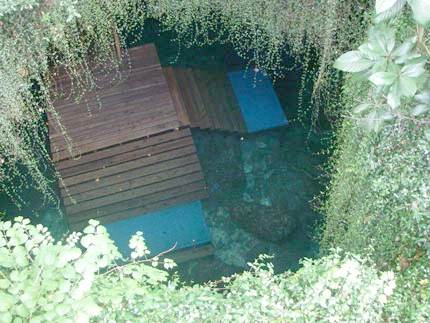
The only access to Devil's Den is through a narrow side entrance hewn into sheer rock and then down a long flight of wooden stairs that terminates on one of several wooden platforms. You see, despite its ominous name, Devil's Den is primarily a training place, one where new divers can practice in a calm and always crystal-clear body of water that is a great deal more interesting than any pool could ever be. So Devil's Den is both a training facility and a prehistoric place with fossils from the Pleistocene as well as finds from the era of early men, going back perhaps 75,000 years.
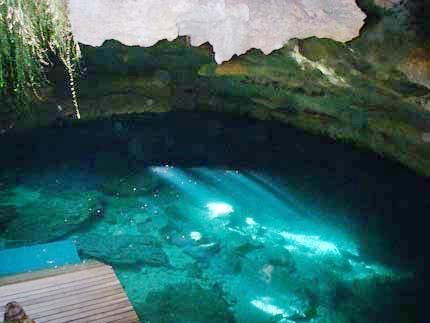
To dive Devil's Den you register in a small shack-like building in a lush and totally picturesque setting that alone is worth the trip. You then set up your gear on one of the many park benches as there is no place to leave things down in the cavern.
Get all suited up and then descend down the stairs, making sure you don't bop your head against the low ceiling up on the wall and don't slip on the steep stairs. When you first look down onto the water in the cavern it seems quite shallow, no more than eight feet perhaps. It also looks far from impressive. 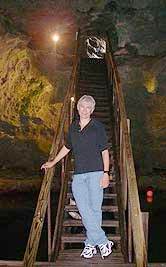 That is an optical illusion. Most of Devil's Den easily reaches 25 feet or so. Venture down into some of the rocky areas and you find yourself at 40 feet, and some of the nooks and crannies are probably 50 feet and more. As you go deeper, there is some overhang on the sides, giving the site a cavern-like appearance, even though technically it is not an overhead environment.
That is an optical illusion. Most of Devil's Den easily reaches 25 feet or so. Venture down into some of the rocky areas and you find yourself at 40 feet, and some of the nooks and crannies are probably 50 feet and more. As you go deeper, there is some overhang on the sides, giving the site a cavern-like appearance, even though technically it is not an overhead environment.
Devil's Den is home to the biggest catfish I have ever seen. One was so large we called it "the bus." It was as big as a child. The catfish swim around calmly, knowing that no one will bother them, except, perhaps, with the flashlight of a camera. There are other fish and some crabs, but the biggest attraction is the incredibly clear water that lets you see, well, everything. The underwater scenery is awesome, with interesting rock formations on which you can practice pulling yourself along, cave diver-style. There are stalactites to see, and, of course, the wooden training platforms. The water is a pleasant 72 degrees and stays that way all year.
Amazingly, on this Thursday afternoon we had Devil's Den all to ourselves. That was nice. I first got acquainted with the site, cooled off from the heat accumulated from putting on the 7mm wetsuit in a hot and muggy Florida afternoon and then walking down the long flight of stairs with all that heavy scuba gear. 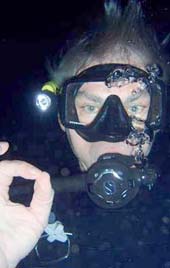
We then tested my buoyancy skills and did some exercises. I then demonstrated that I remembered the basic skills from my open water certification classes: flood and clear the mask, take the mask off completely and put it back on, switch regulators, and so on. We then swam around and over a small cliff that descended into a deeper area of around 40 feet. I had a small LED flashlight mounted to the strap of my mask and was amazed at how much light it produced. I also had with me one of the underwater cameras we had brought along to review, an Olympus 720SW in a deepwater case. I probably spent an inordinate amount of time pushing its buttons. I did get some good shots, though not as many as I'd have liked.
We did two "free" dives, just swimming around and exploring. I also learned two new skills. One was rescue diving and the other light salvage. In rescue diving I learned what to do should I find an incapacitated diver underwater. Approach, try to get his or her attention, see if the diver is conscious. If not, turn them head-down, grab their tank between your knees, reach around their neck and open the windpipe by bending the head up and backwards a bit. Hold the regulator in, then ascend to the surface, being in control of buoyancy. At about six feet from the surface lean backwards so the victim gets turned around and breaks the surface first, face up. Inflate the BC, remove the mask, check for breath, do mouth-to-mouth if necessary, head for land.
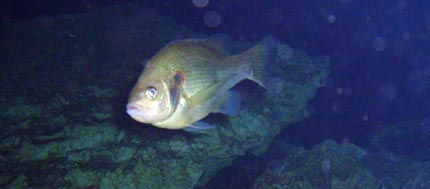
Light salvage uses a lift bag to bring objects up to the surface. It's important to know the lift bag's lift capacity in pounds and also the approximate weight of the object. In our case that was a weight belt. You use your mouth or the regulator to inflate the bag, and then ascend with it, holding on to the deflation string in case the bag wants to go up too quickly. As always, watch the speed of the smallest bubbles so that you do not ascend too fast.
Our time at Devil's Den was over all too soon. 5PM. Last dive! We barely had time to admire the adjacent facilities that include a large, man-made body of water that had been conceived as a scuba training park, but was never finished because it got flooded before the drainage and pumping systems were in place. So now it just sits there, silting up. Too bad.
We had our tanks filled, then headed for Crystal River where we stayed at a Best Western close to the dive shop from where we'd snorkel with the Manatees the next day and then visit more dive sites. But before that we had a night dive on the agenda.
Crystal River Pier
Night diving can be a daunting proposition even for seasoned divers. Some never lose the fear of the unknown even if they have hundreds of daylight dives or more. To delve into the black waters, even knowing exactly what is in there and what is not, is an experience wholly different from diving during the daylight hours. In that it is perhaps no different from the fear we can experience during the night, even sleeping in our very own bedroom. Everything looks different, and irrational thoughts enter the mind. Things can grab you.
I did not exactly feel like that, but I also did not know what to expect. I already knew from Devil's Den that even a smallish flashlight can cast a surprisingly strong beam and illuminate a large area. I had been told basic underwater light etiquette. The most important: never shine your light into a buddy's face. It takes quite some time to acquire one's night vision. It takes just a split second to lose it again.
So we geared up at the Best Western in Crystal River and walked a block and a half in stifling heat and humidity to the pier from which we'd have easy access to what those who know it call "Catfish Motel," a bowl at perhaps 25 feet right under one of the boat docks.
Getting into the water was not much fun as there was plenty of decaying slime and ugly weeds. We waded through it all, tried to avoid the worst, yet still got plenty caught in our gear. The smell wasn't pleasant either, and mosquitoes buzzed around our heads. The instructor had not been to the place in a few years, but eventually located the dock. We decided to go down to look for the entrance. I turned on my flashlight and we descended into the murky water. I could see the instructor's beam but not much else. We looked around but saw nothing, so we came back up. Carol then said she was going down again and that I should follow if she gave me a sign by moving the beam of her flashlight up and down. I waited, saw her beam grow dimmer until it almost disappeared, then saw the sign.
I took a deep breath, put the regulator back into my mouth, deflated my BC and descended, just to quickly bump into something. It felt like a ledge covered in slime, and I began falling backwards into it. That was not a pleasant experience and I tried to right myself. Carol appeared, helped me up and we went back up. I told her I didn't feel very comfortable due to all the slime and the very poor visibility. She said she had found the entrance and it was right below us. So I decided to face and overcome my fears and go down. Sure enough, I landed on the bottom right next to the entrance. I saw Carol descend into the hole, but myself held on to what appeared to be some wooden structure for a bit. A lot of slime and debris floated up out of the hole and so I held on to the wood to see if it cleared. I saw Carol's light beam below me, the water coming from the enclosure below cleared and I descended into the bowl which measured perhaps 10 x 20 feet. Once inside, the water was very clear.
We used the flash lights to explore the area which was mostly rock and sand. We saw numerous small catfish, some other fish and some crabs that menacingly swung their claws at us. The rock formations looked interesting, and certainly more so than what I had expected from the slimy, murky pier and dock area. I didn't move around much so as not to stir up silt. The light beams illuminated more than I thought. It did not feel like sitting in a pitch-black bowl; rather whatever our beams touched was lit up quite a bit. It wasn't scary at all. I looked up several times just to make sure I could still see the entrance. Carol later told me that the wooden beams and poles I had seen were just remnants of an old pencil factory, and not part of a structure as I had assumed. The beams didn't seem very secure and could probably fall into the bowl. In any case, we easily made it back out and to the surface. Carol high-fived me and I had completed my first night dive.
The flashlight I used was just a small hand unit with LEDs and powered by a couple of AA batteries. Yet, the beam was strong and the batteries did not weaken during the hour or so that we used the lights in Devil's Den and during the night dive. They did not have an on/off switch; you simply turned the front of the light to make contact with the battery and turn the light on. It also had a clip to attach it to a belt, the mask strap or another part of the dive gear.
Getting out of the water meant swimming back to the pier through all the slime, and then trying to get off as much of it as possible before stepping out of the water. And then walking back to the hotel with all our gear still on.
Back in the room I noticed that some of my fingernails were hurting and showed signs of infection. Just what I needed. I made a mental note to stop by a drugstore in the morning and buy some antibiotic ointment.
Crystal River: Swimming with Manatees tour and Three Sisters
On Friday morning we had to get up early for our Manatee tour. We were to be at the dock 6:15am sharp, which meant getting up at 5:15, which was more like 2:15am to my internal Pacific Standard Time clock. Manatees are large mammals that seem like a water-based cross between cows and elephants. They have smallish flippers that I was told had bones that feel like arms and fingers. Their faces and tails look unlike those on any other animal. They sleep a lot, come up for air every few minutes (and less often when they sleep). They apparently seek out the Florida river areas during the winter time.
Manatee tours are conducted from pontoon boats by businesses that are often also dive shops. Our tour was by the Birds Underwater dive shop and tour operator located right on the water. Captain Kris, a lively, friendly woman my age greeted us and gave us the required waivers and papers to sign. Eventually everyone arrived, and all ten of us boarded the boat with our gear. No Scuba gear required, but we did need to don our wetsuits and brought snorkels and fins. I had also brought along the Pentax W10 digital camera, a 6-megapixel device waterproofed to five feet.
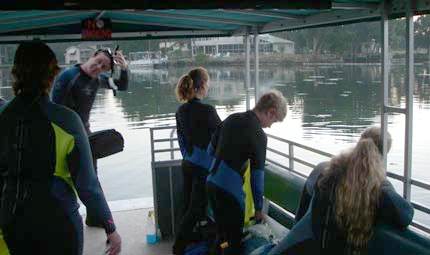
After a pleasant ten minute dawn ride on the water Captain Kris began searching for Manatees and we quickly found a couple. I saw them from the boat and took pictures of them. We put our fins on and got into the water that felt just fine with my thick 7mm neoprene wetsuit. I put on the mask and looked at the bottom of the perhaps five to six foot deep water.
I decided to take some test pictures to get the hang of shooting underwater with this camera that did not need a special protective case, but the camera would not focus or change modes. I tried to turn it off and then on again when I saw an ominous sign: small air bubbles emanated from the camera's speaker. I examined it and found that the battery/memory card compartment cover with its rubber seal had worked its way partially open. The camera was flooded. I immediately realized it was my fault. I had not activated the safety latch when I had put in the battery. I was angry at myself, yet also felt that the latch should close itself without the need for a manually operated safety latch.
I decided to look for the Manatees and quickly saw one. It was a white one, all clean and smooth, without any barnacle and algae growth on its body. The animal peacefully munched on vegetation at the bottom. It was grazing and didn't pay attention to anything else. I watched the magnificent creature, following it as unobtrusively as I could. I had watched the instruction video on what one can do and must not do with Manatees and I was certainly not going the break the rules. After a couple of minutes the Manatee went up for air and quickly came down again. It only stuck its snout out of the water the tiniest bit, just enough to take a breath, and then came right back down. It blew bubbles when underwater, but it wasn't clear where exactly they came from.
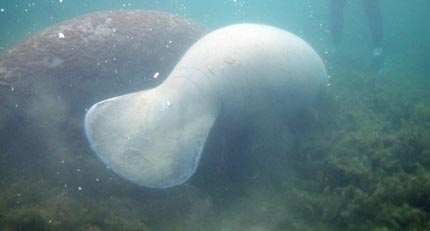
I then joined our group, some of which stirred up silt and gunk with frantic fin movements. Quite annoying and entirely unnecessary. Fortunately I spotted another Manatee, a larger one with considerable algae and barnacle growth on its body, and followed it for several minutes. By now I was using the Olympus Stylus 740 in its underwater case made of clear acrylic with red trim. I eventually touched the Manatee's back. It felt smooth and firm, with just a bit of give to it. I tried to float and move with as little movement as possible, so as not to disturb the animal.
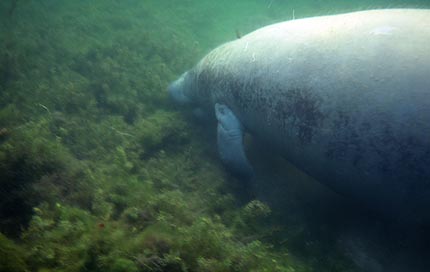
Time quickly passed. Captain Kris, who was shooting video of the Manatees and us snorkelers, recalled us to the boat as she was hoping to find more playful Manatees that would interact with us, as many do. We looked around but no luck. So the Captain decided to move on to another location. Still no luck, so on we went to the next stop of the tour.
"Three Sisters" is an underwater spring-fed area of brooks and bowls. It is crystal-clear with lots of wonderful underwater sights. Snorkeling up the spring, we saw logs, rocks, plants and plenty of fish. Eventually we came to an area that apparently had been fenced off by underwater piles, the remnants of which formed sort of a stockade. I was told that Jacques Cousteau had had the piles installed as part of a Manatee research project.
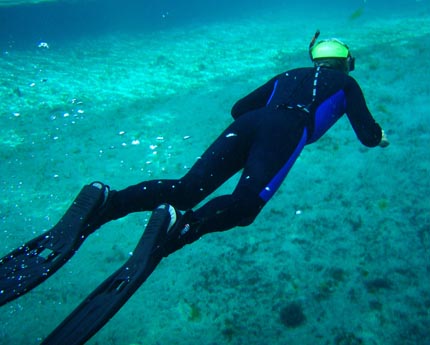
This area was larger and had a deep basin from which the underwater springs came from. The water was totally clear. Some of the group who were good breath-hold divers dove down and underneath the logs at the bottom of the hole. I attempted to go down, but continued to feel the same sinus pressure that had bothered me at Devil's Den. I had never suffered from that before and wrote it off as either a leftover from my flight or perhaps a night spent in a smoker's hotel room. So instead of diving, I gave the camera a good workout and also shot some video. Then it was time to return down the "Three Sisters" exit stream and to the boat. We boarded the boat, got out of our wetsuits and enjoyed the return ride. The pontoon boats actually even have an opaque plastic changing chamber. European customers usually laugh at it as they do not share American's inhibitions.
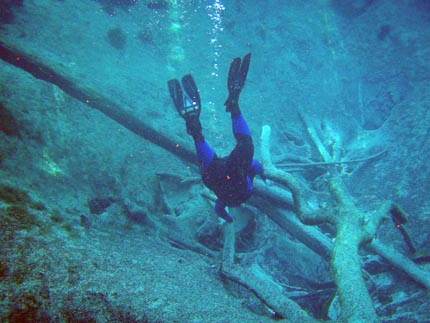
Back at the dive shop I examined the pictures I had taken. On the small onboard LCD of a digital camera, even if it is a modern one with a good 2.5-inch screen, it is always difficult to see how good a picture is. I was disappointed with some, but others seemed fine. And the video had come out great. I showed it to Captain Kris who was thrilled and inquired about the make and capabilities of the little digicam. However, what I had taken completely paled in comparison to the video Kris had taken with her 3-CCD vidcam. It was playing on a large flat panel HDTV. The picture and clarity were spectacular, and Kris quite obviously had not only great expertise with the underwater video camera, but also one of anticipating the animals' movements and actions. I bought a copy of the video, burned on DVD. It cost US$40, but was well worth it.
Crystal River: King's Spring
Next on my list of skills to acquire and practice were compass navigation, use and deployment of a safety sausage, and using underwater scooters.
Thanks to the friendly relationship between our instructor and the dive shop owner, we lucked into getting underwater scooters and an unscheduled boat ride to a more open area of the Crystal River, one that contained a large, round underwater bowl, roughly 200 feet in diameter, called King's Spring. It is famous for its usually very clear water and caverns that can go down to about 65 feet [see cut-away of King's Spring]. We loaded our gear and the scooters onto the boat and headed for the dive location. The wind was a bit stronger now and the water a bit choppier. Captain Kris, who again piloted the boat, had a hard time getting the anchor to hook, but eventually managed.
The skill I was to practice was underwater compass navigation between buoys. Determine a course to the first buoy, set one for a second, reverse that course by 180 degrees, then set for a third buoy, then head on back to the boat. It turned out that this was a good day for compass underwater navigation, although not necessarily for diving: the water was green and murky with visibility not much past five to seven feet. Nonetheless, we dropped down to ten feet and then swam over the almost vertical walls of the equally murky underwater bowl of King's Spring. When we went up, it was right at the buoy. I hit the second one as well, and also the reversal and the final one. Heading back for the boat I got off-course a bit because my body kept rolling due to the uneven drag resulting from holding one arm up in front of my face so I could see the compass reading. I found I did not like a wrist-mounted compass.
Next the instructor explained what a rescue sausage was and how to deploy one. It is essentially an inflatable tube with string on a reel. The idea is that it can be deployed from underwater to attract attention, as an ascent line, or also on the surface when a diver gets lost. This exercise was going to be done from the bottom of the bowl, a prospect I didn't especially cherish in the murky water. We descended anyway, past the bowl's walls and to the rocky bottom. We saw the "Manatee monument," a large, heavy block of stone inscribed with a statement about the importance of preserving the Manatee. At the top of the stone was a small Manatee statue. This was not, Captain Kris told me, the original bronze statue that had been stolen, but a stone replacement.
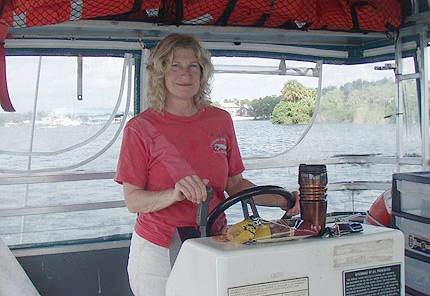
The instructor demonstrated how to use the rescue sausage. First remove the carabiner clip from the sausage and clip it onto your BC. Then pull off the elastic band that holds the rolled-up sausage. Put the reel with the string onto a finger and make sure the string reels off as it should. Either use the low pressure hose from your BC to blow some air into the sausage, or do it with your mouth. Only inflate it a little as the air will expand as the sausage rises to the surface. Then let the sausage rise to the surface and go after it, reeling in the expended string. On the surface, fully inflate the sausage if needed.
Then it was my turn. We descended into the murky bowl again and I did the exercise without any problem.
We swam back to the boat, climbed up and, after a rest, lowered the underwater scooters into the water and secured them to the boat. Underwater scooters are essentially big plastic cans with a large propeller powered by an electric motor. Ours were small models roughly the size of a ShopVac. We had two different models, a smaller orange one and a larger blue one. The scooters have two handles. Either one or both handles have on/off triggers for the motor. The scooters are neutrally buoyant, but must be clipped to one's BC so they do not get lost. To use the scooter, you straddle it underneath your body, propeller facing backwards. I took the smaller orange scooter.
After the customary "ok" and "down" sign, we descended to the bottom at about eight feet, making sure to keep the scooter off the muck and seaweed. I pushed the trigger, the electric motor whirred and off I went. I heard the instructor's more powerful motor kick in and looked back to see her. It was fun to be pulled instead of having to swim. Steering simply meant holding the scooter in the direction you wanted to go.
I quickly found that though the instructor had her scooter motor run all the time, she apparently could not keep up with me even when I just blipped the motor on and off. I figured she was just playing with me and decided to dash off and have her come after me. Instead, she disappeared and I could no longer hear her scooter. I had fun moving on and about, even descending into the bowl a bit.
After a while I came back up and returned to the boat where Carol was already waiting. She confirmed that her blue scooter was not moving very fast. I offered to switch and we went down again. I found that the blue scooter, despite its obviously powerful motor, barely had enough punch to pull me up. I tried to get it to move but didn't go anywhere, so I came back up and returned to the boat. Later we'd find that there was nothing wrong with the scooter; it's just that they have adjustable propeller blades and we didn't set them right. The blades in the orange scooters were adjusted for maximum thrust; the ones in the blue ones needed to be set to the proper angle. Live and learn.
Back on dry land we stowed our gear away and headed for Cedar Key where we were going to stay for that night and the next. I noticed that the tips of my fingers hurt more. I examined each and found that by now most were affected and some even bleeding a bit. It was as if the sides of my fingernails had pushed into the soft cuticle flesh next to them and cut it open.
All of a sudden it dawned on me what had happened. It was the wetsuit! Wetsuits are notoriously difficult to put on. You have to grab the thick neoprene material and pull it up your arms and legs. It's a total struggle, and one that I had gone through several times. Each time I grabbed and pulled, the skin on my fingertips had gotten cut by my nails, short and neatly trimmed though they had been. Learn something new every day. And it was just another in a long series of things that happened that I did not expect, and that had never been mentioned in any classroom material, manual or book.
Manatee Springs State Park: Catfish Hotel
On Saturday, the second to final day of the trip, we headed for Manatee State Park where I hoped to complete the deep dive portion of my training. "Deep dive," in NAUI's terminology means deeper than 60 feet. The dive site at Manatee State Park, Carol said, might yield just over that.
I found the park to be a large, wonderful nature preserve full of luscious cypress trees around another of the spring-driven small rivers that form bowls and basins along the way. West Indian manatees use it as a winter refugee, but they had not arrived just yet. I also found two totally different diving environments.
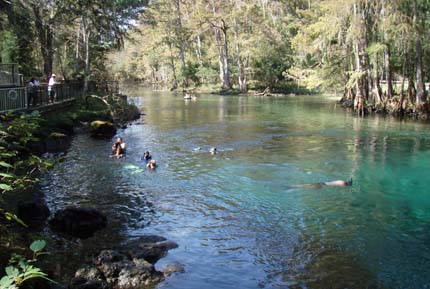
On the one side was "Catfish Hotel," not to be confused with the cavern in which I had done my first night dive, and an almost perfectly round bowl in the midst of forest. The water's surface is completely covered by duck weed, a tiny plant that looks like a miniature clover leaf and floats on top of the water. This made the entire bowl look green. Carol described this as one of the most amazing underwater sites anywhere. I had a hard time imagining how there could me much to see under that green blanket.
Carol also explained that at the bottom of Catfish Motel was the entrance to a downstream 500-foot cave that connected the bowl with the basin on the other side and then the small river. Open water divers were forbidden to enter the cave, and also forbidden to carry a flashlight that might tempt them getting too deep into the cave's entrance. That could be dangerous as there is a strong siphon, with water rushing into the cavern. As many as 100 million gallons a day. (see detailed site on the Manatee Spring Cave System)
We then walked over to the other side where I found a crystal-clear basin with a good number of swimmers and snorkelers. The difference between the green bowl and this sparkling basin could not have been greater. Elevated wooden walkways allowed us to enjoy the Florida forest and brush along the river, and the river itself. We saw groups of turtles lazily sunning themselves along the shores, and the water was clear enough to see the bottom, always. We could have spent hours hiking through the park, but we had come for diving and so we returned to don our gear.
After the customary struggle with my thick, elastic wetsuit I was fully suited up and we marched to the entrance of Catfish Hotel. It seemed off to step into the duckweed covered water. We laughed and joked and took a number of pictures. Then we went under.
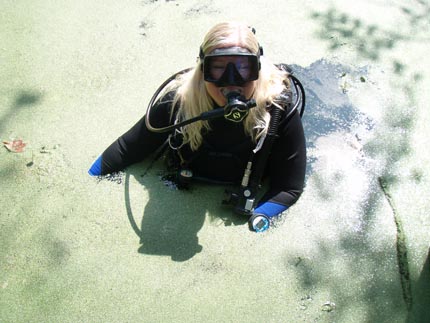
What greeted me was the most amazing sight I have ever seen, more stunning even than Devil's Den. Much brighter than expected given the thick, uninterrupted duck weed cover laid a greenish-blue bowl with submerged trees, rocks, shelves, boulders and a variety of fish. Rays of sunshine broke through the duck weed here and there, making for an incredible effect. Pixar couldn't have done it any better. We sat on a slightly descending ledge below which lay all that wonder. I was slipping and couldn't get a hold, not wanting to stir up too much silt to mar this wonderland.
Then I saw the instructor giving the "up" sign. That surprised me, but I followed. We broke the surface, all covered by the tiny plants. I wondered why we'd come back up.
"Umm,... I feel I need to tell you that there is a gator in there," she said.
Turns out she had spotted an alligator on the side of the bowl. It wasn't a large one, perhaps four feet or so, but an alligator nevertheless. The first thing that came to mind was that if this was a young, a much larger mother alligator would be close by. I told the instructor I wasn't comfortable with that. She agreed but said she'd go back in to check things out. Which she did. Apparently there was no other gator and so I decided to go in.
The scenery was simply incredible. It was like being inside a movie, and hovering at the same time. The water was totally clear, and so I had no problem at all following my instructor down the slopes and rocks. We checked out this and that, and I was just overcome by the sheer wonder of it all.
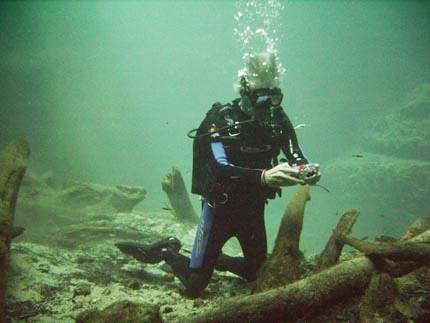
Carol swam deeper towards the one side of the bowl where the bottom descended lower and I saw that this was the entrance to the cave. 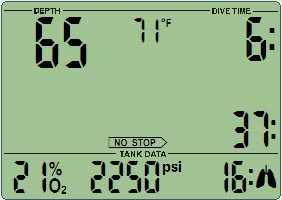
She motioned for me to follow her but hold on to whatever I could find. I cautiously went after her, making sure I could stop if I felt a strong current. Deeper we went and it got a bit darker. Yet, turning around and looking up we saw the blue-green light with the rays of sun breaking through. I glanced at the display of my dive computer and saw, much to my delight, that it read 65 feet, more than enough to meet the depth requirement. We stayed there for ten minutes or so, looking around, examining things, then ascended a bit.
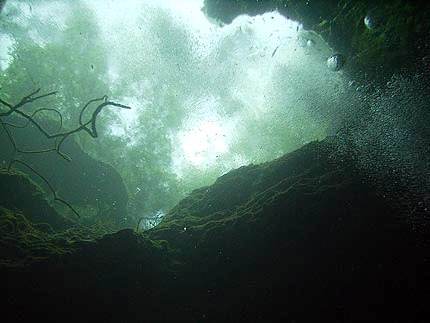
For the next 20 minutes we explored this magical bowl, taking lots of pictures, me with the Olympus Stylus 740 in its deepwater case and Carol with her Reefmaster dedicated diving camera. Twice she motioned me over and pointed at something way up high. I looked but could not figure out what she was trying to show me. I had a suspicion it was the alligator, and later found that that was correct. She'd kept an eye on it the whole time.
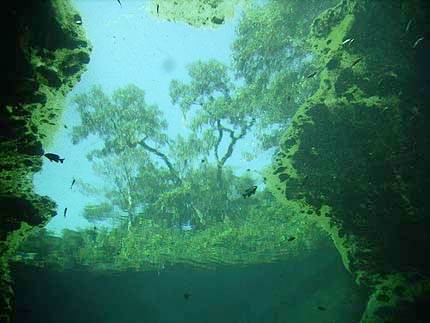
I was elated by the time we emerged from the water, once again covered in duck weed. A couple of hikers approached as we climbed up the stairs and we told them about the gator. They did not seem surprised and we learned a few things about gator sightings in the area. Then it was time to rinse off a bit and walk over to the other side and into the clear pool basin.
Manatee Springs State Park: the other side
While Catfish Hotel and the clear pool couldn't have looked more different from the surface, underwater they were similar (though the hotel was far more varied and spectacular). The lack of weed made this pool much brighter. We quickly descended into the deep part and looked at the snorkelers above us. Some occasionally dove down and we watched them do their thing.
I quickly saw the cavern exit at the deep end of the basin. It was well lit and not as intimidating as the larger, deeper, darker entrance in the bowl. Carol went down and close to it and motioned me to follow. I did and soon felt a strong blast of water rushing at me. It was so strong that it clear blew me away, literally. I made sure I wasn't ascending to the surface by dumping air out of my BC which brought me back to the bottom. I returned to the cave exit, this time holding on to a piece of wood so I could visually examine the area without being carried away by the water pressure emanating from the cave.
Looking over at my instructor I noticed that she seemed to be struggling against her BC. She then began undoing the belt and clasps and was clearly taking the BC off. Knowing her expertise and poise underwater, I wondered what she was doing. She did not seem in trouble or panicking, and so I concluded she was doing some sort of instructor exercise. I thought perhaps she wanted me to follow her example, but that was not the case. I also remembered that she'd taught me it was never a good idea to take off a weight-integrated BC underwater. Once she had the BC off she turned around and I saw what the problem had been: the zipper on the back of her wetsuit had opened and she needed help in getting in closed up again. I saw her shivering in the blast of cold water.
Once that crisis was resolved we enjoyed hanging there in the strong current, holding on to rocks and then our bodies wave like flags in the wind. It gave me an idea just how strong underwater currents can be, and how difficult it would be to fight them or swim into them.
Later, we explored the shallower parts of the basin. I picked up a bunch of shells whose mother-of-pearl surface gleamed like silver. Carol found a tiny flounder. I had always thought flounders swam upright, but this one was horizontal, like a manta ray, and perfectly camouflaged against the sandy bottom. Carol picked it up, filled the inside of her mask half with water, and actually placed the little flounder inside the mask for a photo op. She likes animals, all of them.
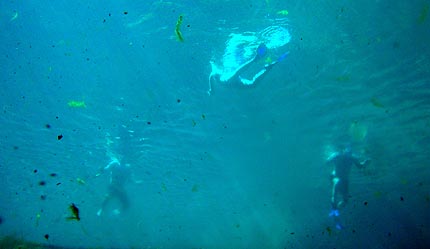
So that was the final dive of the trip. Eleven dives in all, which more than doubled the grand total of my dives. I felt thrilled, happy, fulfilled, and proud, and didn't want for it to end. I can see how diving can suck in a person, become an overpowering passion.
The long flight home gave me an opportunity to reflect on all that had happened. I put my laptop computer on its lowest power setting and just typed and typed, eager to put everything in words, everything that I remembered while it was all fresh in my memory. The computer, though its battery was old, gave me a good three hours and that was enough to record several thousand words of memories. When it finally conked out I saved and leaned back into my seat and closed my eyes. I was happy that I had captured the memories, though I knew that some would remain with me for as long as I lived regardless. I was sad that it was over and wanted nothing more than to go right back, set time back.
When I landed in Sacramento I took my time to get to the baggage claim so I would not have to wait for the bag with all my gear. I waited anyway, a long time. The airline had lost my bag. Oh well. I knew it'd arrive eventually, and it did late the next day. I was just glad it did not happen on the way down.
Posted by conradb212 at 11:01 PM
October 26, 2006
Underwater photography
Even the most enthusiastic diver spends most of his or her life above water, and so we are used to the sights around us and the way things look on dry land. For many, the wondrous world we see beneath the surface lives as memories burned into their minds forever. Those of us who are into photography will inevitably feel a great urge to capture those sights with a camera. I am glad that I have now become comfortable enough underwater that I can take a camera along instead of being preoccupied with my equipment. It's fun, adds to the experience, and you end up with pictures of what you saw down there.
Even though I consider myself a decent photographer, and even though as co-founder of Digital Camera Magazine in 1998 and running it for eight years I have plenty of experience with all sorts of state-of-the-art photographic equipment, I quickly found that things are different underwater. As a result, I have a new appreciation for the talents of the people who shoot those wonderful, glorious pictures in our galleries here at scubadiverinfo.com and in many other places.
Last week I had an opportunity to test three cameras on a certification trip to several diving locations in Florida. The cameras I took with were not dedicated underwater equipment, just regular digital cameras that you can use near, in, and under water, with some limitations. I chose two that are inherently waterproof, the 6 megapixel Pentax Optio W10 and the 7.1 megapixel Olympus Stylus 720SW. They are sealed so you don't even need a special underwater case for them down to about 5-8 feet with the Pentax and 10-13 feet with the Olympus. That makes them perfect for snorkeling and even scuba in shallow sites. I also brought along a 7.1 megapixel non-waterproof Olympus Stylus 740 with a special deepwater case. Deepwater, in this instance, meaning it is rated waterproof down to 133 feet, the generally accepted depth limit for recreational diving.
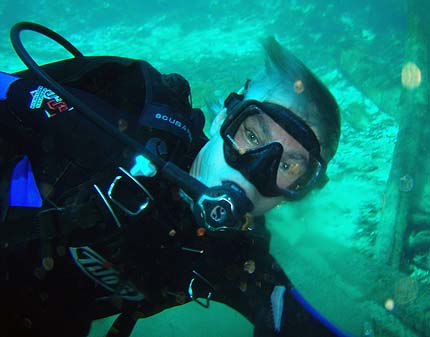
The picture above shows that the cameras work. That's me on a training dive at Devil's Den in Williston, Florida. It was taken with the Olympus 720SW in its waterproof housing. We ended up spending hours underwater playing with the cameras. With varying success.
We did two different kinds of testing. One deepwater (down to about 70 feet, which is as far as we got on the dive sites we visited) with the waterproof cases, and one snorkeling without the cases. The latter took place during a Manatee tour where Captain Kris of Birds Underwater in Crystal River, FL expertly located some of those magnificent creatures. We used snorkeling gear to follow them and watch them grazing and gracefully gliding through the shallow waters.
Getting back to the cameras... I flooded the Pentax during that swim. It has a special safety latch to lock the rubber-sealed battery/memory card compartment door, and apparently I had forgotten to activate that. So I swam, looking down and trying to focus but the camera did not react. Instead I saw tiny bubbles come out of its speaker. Not good. I turned it around and sure enough -- the door was no longer closed tightly. I returned to the boat to assess the damage. The memory card and battery were wet and the camera clearly flooded and dead. So for the rest of the Manatee adventure we used the Olympus Stylus 720SW. Olympus chose a latch design that locks automatically, thus precluding operator error. A wise decision. The Pentax episode actually had a happy ending. Not only was I able to recover all the pictures from the wet 1GB SanDisk SD card, but after taking the Pentax apart and drying everything (not recommended for the mechanically challenged!), the Optio came back to life, working flawlessly.
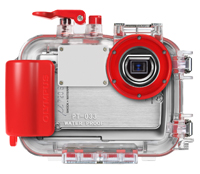 The underwater cases for the Olympus cameras are most impressive. They are made of thick, strong, clear acryllic with red seals and trim. That makes them very attractive but they are also very functional. Olympus has a dedicated case for many of their cameras, and each allows access to ALL of the hardware buttons. The buttons are different colors so that it is easier to figure out which is which underwater. Good thing, too, as the imprinted text labels on the buttons are difficult to read.
The underwater cases for the Olympus cameras are most impressive. They are made of thick, strong, clear acryllic with red seals and trim. That makes them very attractive but they are also very functional. Olympus has a dedicated case for many of their cameras, and each allows access to ALL of the hardware buttons. The buttons are different colors so that it is easier to figure out which is which underwater. Good thing, too, as the imprinted text labels on the buttons are difficult to read.
As one might expect, condensation is an issue when you go from the hot and very humid Florida climate into the cool water of a spring-fed dive site. The Olympus cases use little desiccant packages that you place inside the enclosure. There is no dedicated place for them and so they can fall out. You also need a new one every time you use the camera underwater, which can be a pain. As is, we found significant condensation even with a desiccant package. I opened the case to wipe it off, and the little package promptly fell into the water and we had to use the camera without it.
Consumer cameras that can be used underwater either with or without case usually come with a few special underwater modes. They generally include a snapshot mode, a macro mode, some wide-angle mode, and perhaps a movie mode. Neither the Pentax nor the Olympus manuals were clear on what settings the cameras used in those modes. As it turned out, the macro mode on the Olympi worked very well, rewarding us with some cool underwater close-ups. However, the wide-angle modes pretty much flopped. Neither of the two Olympus cameras tended to focus properly for us, and in low-light conditions the shutter speed seemed so slow that many shots were all blurry. And the internal flash, even with diffuser plates on the acryllic cases, illuminates scatter more than the subject. For comparison we had taken along a Reefmaster camera. It's really just an inexpensive digital camera with special underwater programming. It, having been designed for underwater use almost exclusively, proved superior.
A conference call with Olympus after the trip yielded a lot of good information. First, the obvious: even if you're the type who does not usually study the manual, when you go underwater, do. And spend a good deal of time practicing with the buttons and modes. Once under, you do not want to spend all your time pushing buttons on the camera. Second, practice with the fixed focus and autofocus modes to see what works best. Third, we had neglected to experiment with autofocus lock and digital image stabilization. Fourth, and most importantly, realize that while the Stylus 740 is a point & shooter, you can actually change settings in the modes. Using a higher ISO setting instead of leaving it on automatic would have resulted in higher shutter speed and sharper pictures. And so on. Practice is key. And I wish I could go back and try again, applying what I learned.
I have no doubt that I'll learn a lot more about underwater photography on upcoming dive trips. I also bought the PADI "Digital Underwater Photographer Manual" to see what the diving experts recommend. I do already know that bringing a camera along greatly adds to diving fun.
Posted by conradb212 at 11:00 PM
October 13, 2006
What the PADI and NAUI classes don't teach
I've spent far too many years of my life studying. I don't really regret it and the degrees generally came in handy, but if I had to summarize my overall impression of our educational system, there's one vexing and rather inexplicable aspect that'd rank high on my list: There's always a bunch of really important stuff they never teach you in class. For example, I managed to graduate as an architect without ever being taught how buildings are financed. Duuh... sort of important. Maybe educators view some things as so self-explanatory that it never occurs to them to include them in their curriculums.
I found the same to be true with diving classes. The PADI Open Water course book was certainly comprehensive and very helpful, as was the accompanying DVD. Same for the NAUI "Scuba Diver" coursebook and its DVDs. Both are professionally developed and cover a lot of ground. But there's one thing both overlook, and that is the simple logistics of diving.
What do I mean by "simple logistics"? Well, diving involves a lot of gear. And then there is all the additional stuff you generally keep closeby, like wallets, keys, cellphones and other assorted personal items. By "logistics" I mean what is the best process of making sure you have all your gear, don't exhaust yourself taking along stuff you don't need, where do you put it all as you travel, what do you actually take diving, how do you set up a "base camp," and what do you do with valuables?
Experienced divers will probably look at the above paragraph and go, "Hahaha! What is he talking about? There is nothing to it! Noobs... how stupid can they be?"
Well, yes, I am sure there is nothing to it. Once you have figured it out by trial and error, that is. I also race cars as a hobby. I go drag racing. The first time I went to the track, the logistics seemed overwhelming. There were hundreds of cars in many lanes and I had no clue how it all worked. They all seemed to just do the right thing, moving and staging and racing, and then finding the right place to return to. It was like a giant ant hill -- you have no clue what's going on or how the ants do what they do, but it all functions as smoothly a clockwork. Well, it took me two or three nights at the track and then it all made sense. It all became quite logical and self-explanatory.
But let me explain what, to me, the "ant hill" looks like in diving.
During checkout dives I wondered when to put the wetsuit on. Does one do this right away, or just before diving? And where do you do it? In your car? In the bathroom? In front of people? Behind a bush? And what should you wear underneath? Underwear? A bathing suit? And what do you do with it during surface intervals? Leave it on all the way? Roll it down? And when you're done and it's all wet, what do you bring with you to stow it in so your car doesn't get all wet?
Then the tanks. We took two. Do I shlep both down the hill to the "base camp" (we had two: a couple of picnic tables higher up and then a few blankets close by the water)? Or do I leave one in the car and only take the one I use? And the BC? Do I put that on right away? With the weights? Or do I assemble the gear down by the water and wait til the last minute to put it on? And so on.
Most importantly, what do you bring along and what do you leave? Will there always be a designated person who stays at the base camp and makes sure nothing gets lost or stolen? How does one handle wallets? When diving a lake, it may be okay to simply leave the wallet in the car and lock the car. But in other locations you may need the C-Card and some money, or perhaps even ID. What do you do with it while diving? I wouldn't want to simply leave it on a beach blanket. Neither do I want to leave my camera or my smartphone. And I sure need my reading glasses!
Well, so lock the stuff in the car. Fine, but then you at least need to take the car keys with you. Lose those and you're really in a mess. So do I take them with me while I am diving? Put them in some pocket and hope they don't get lost, or snap them onto some ring or such? Well, if so, le'ts not forget the remote control FOBs that almost all cars have these days. They are certainly not waterproof. And more and more car keys have electronics built into the key's plastic or rubber head itself. Is that waterproof? Probably not. There's always the "valet" key, but not all cars come with one, and I have no clue where mine is.
Can you see now what I mean by "logistics"? What do you take? What do you leave? Where do you keep it? How do you make sure you don't lose important stuff, or find yourself without it when you need it?
See? Some things in life they don't teach you. You just have to find out for yourself.
Posted by conradb212 at 11:00 PM
October 3, 2006
What to do between diving opportunities
Unlike golf or bowling or other pastimes with venues nearby, scuba diving, for most of us, is a sport that requires careful planning ahead. You can't just pick up your gear and go do it whenever the mood strikes. So what does a diver do between diving opportunities? And how does one guard against losing interest or drifting away from the sport? After all, there are statistics that say an alarming number of newly certified divers never go diving again, and an almost equally alarming number gets lost to the sport every year, just because it becomes too cumbersome to plan and wait.
Well, one way to keep the flame burining is to stay in touch with other divers. After I got my C-Card, I collected the emails of everyone in my small graduating class and have been sending status notes out on a more or less regular basis. That wasn't met with a great deal of response, but that's normal. Most people read but don't write. I also became peripherally involved with a group of divers who got stranded after their (and my) dive shop closed down. All of a sudden they had lost their focal point, the place where they met and booked their trips through. So they're trying to get together and organize their own trips. I helped by designing a community website for them. It's at www.goldrushdivers.com. Most have known each other for many years and I don't know if I'll become part of the group. But it's nice seeing how divers seek to communicate and organize. And it's practical, too. Group bookings can save money, and it's fun going places with friends.
Another thing I've been doing is reading. A lot. I've bought and read pretty much every scuba book I could get my hands on. Whenever I stop by at my local Borders bookstore I go to the sports section and look for diving books. Considering that there are supposedly millions of certified scuba divers in the US alone, there is a surprisingly small number of books out there for them. Golf? Baseball? Soccer? Tons of books of all kinds, but very few on scuba diving. So far I've read the Complete Diving Manual by Jack Jackson, Diving Science by Doctors Strauss and Aksenov, Diver Down by Michael Ange, Eyewitness Companions: Scuba Diving by Monty Halls and Miranda Krestovnikoff, Neutral Buoyancy by Tim Ecott, Scuba Diving & Snorkling for Dummies by John Newman, and The Last Dive by Bernie Chowdhury. Two or three others I still need to read, and a few days ago I ordered five more from Amazon.
If you want to get the quick and dirty on all of those books, I wrote reviews on each, accessible through scubadiverinfo.com. I also posted them on amazon.com.
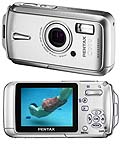 I also plan on doing underwater camera reviews for the website, and started with the Pentax Optio W10. This is not a camera sitting in a separate waterproof housing. Instead, although it looks just like a regular camera and is no larger, it is waterproof all by itself. Pentax says you can shoot at a depth of five feet for 30 minutes. Five feet means it's not a "real" diving camera, though it can likely handle a few feet more. Still, it's good enough to take to wet places and even snorkeling or perhaps river diving. As is, I checked it out in my pool. It was weird dunking what looks like just another little digicam into the water. But it didn't flood and worked perfectly well.
I also plan on doing underwater camera reviews for the website, and started with the Pentax Optio W10. This is not a camera sitting in a separate waterproof housing. Instead, although it looks just like a regular camera and is no larger, it is waterproof all by itself. Pentax says you can shoot at a depth of five feet for 30 minutes. Five feet means it's not a "real" diving camera, though it can likely handle a few feet more. Still, it's good enough to take to wet places and even snorkeling or perhaps river diving. As is, I checked it out in my pool. It was weird dunking what looks like just another little digicam into the water. But it didn't flood and worked perfectly well.
So there. That's what I've been doing since my last dive. And I can't wait to go under again as soon as possible!
Posted by conradb212 at 10:59 PM








